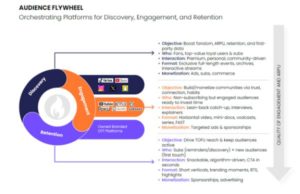
Julien Mandel
Contribution Segment Manager, Ateme
Spectator sports are most engaging when audiences don’t know what’s going to happen next. For the sports broadcasting industry itself, the playing field in which they operate has undergone many exhilarating changes over the last few years. In many cases, these have been accelerated and exacerbated by the Covid-19 pandemic.
As stadiums and venues that were once packed with excitement and atmosphere have been forced to close, we’ve witnessed the increasing significance of over-the-top (OTT) platforms becoming the digital delivery system for the enjoyment and adrenaline sports fans around the world have been missing.
However, costly broadcasting rights that are going up in price and a growing volume of platforms saturating the market mean sports broadcasters are challenged with finding innovative new ways to maintain viewer loyalty.
With this in mind, let’s explore how the events of 2020 will shape the industry in the year ahead:
Standing out from the crowd
It’s almost certain that the growing trend for OTT platforms and an expanding diversity of content will grow this year following the market changes of 2020. Evidence of this is the increased diversity of streaming platforms that have newly bought rights to show English Premier League games, including such platforms as Amazon Prime in the UK. The league itself is even looking at the possibility of launching a Netflix-style service in overseas markets.
Increased market competition has led organizations to devise unique innovations to stand out in a crowded market. It has now become easier to provide a memorable fan experience via OTT to help the consumer feel like they’re part of an event. Advances in technology have allowed innovations such as ‘fan walls’, where videos can be shown of fans from home in order to provide an alternative atmosphere while watching sport away from a venue. This is where OTT holds an advantage over traditional means of television, and it is expected that this will continue to grow.

Personalization gathers pace
The USP of highly personalized experiences is also possible through the use of OTT platforms. It is likely this year that we will see further advances in AI technology and processing which enable additional content on streams to be tailored to each viewer, such as instant replays, interactive video panning, traveling, zooming or audio options such as sports announcers and stadium sound. There is also potential for customized highlight reels featuring the viewer’s chosen sports star or favorite team, with language options depending on location. With an increasing number of viewers engaging with social media while watching high-profile sporting events, many want to see greater integration for posting controls and freedom to customize on-screen stats. Personalization can also provide opportunities for increased revenue, such as tailored advertising for certain groups of viewers.
Delayed events that are now scheduled to take place this year should provide wide-reaching opportunities for broadcasters to provide personalized content, such as the Tokyo Olympics and Euro 2020, if they are indeed able to go ahead. Flexible, cost-effective, and scalable solutions will be needed, and it’s likely that remote production will be required to minimize those ‘on the ground’ should social distancing measures still be required. These advances in technology will enable broadcasters to not only manage events at short notice but also enable personalization in bigger and better ways. The rapid uptake of low latency OTT platforms as the preferred choice of video streaming will only provide greater opportunities in this area.
Boosting privacy and security
Unfortunately, as content volumes grow, opportunities for piracy will follow. Ongoing lockdowns caused by the Covid-19 pandemic have created further avenues for pirates to attract consumers to illegal streams given they are unable to attend events in person. High-value content creates the potential for increased piracy through stolen credentials, and solutions will be needed in order to protect the increased investment from broadcasters moving forward.
However, to combat these risks, the emergence of solutions and standards such as BISS-CA for linear are coming to the fore. In addition, Reliable Internet Stream Transport as an alternative to AEQ proprietary solutions, or Secure Reliable Transport for public internet transmission will also provide opportunities for content to be protected. Furthermore, the increased implementation of royalties on content is another avenue that broadcasters can explore to ensure their investments are protected. Broadcasters should look to react quickly to potential piracy threats with software that can be adapted and evolved quickly.
Passing it forward
While previous focus may have been placed on hardware, it is in fact software that will continue to drive sports broadcasting innovation this year, especially as more organizations make the move towards IP and cloud technologies. Evident in this software shift is the exponential growth in OTT platforms and solutions that are quickly becoming the go-to platforms for sports fans. In the coming years, technology will drive broadcasters in matching the demand for global sport, which has only increased due to the need for more enhanced content while in lockdowns.
With rescheduled high-profile sports events hopefully back on the agenda for this year, greater focus will be on sports broadcasters to provide a unique and personalized experience to each of their customers. The mission for sports broadcasters in 2021 will no doubt be the responsibility to keep fans engaged with their favorite sporting heroes or teams through the use of intuitive solutions that can match consumer demand and deliver a high quality viewing experience.
- Business Models
- Supply Chain
- Digital Transformation
- Rights & Legal
- Data Privacy & Management
- Financials, Investment & M&A
- Consumer Habits & Experiences
- Sales & Marketing
- Coronavirus
- Human Capital
- Collaboration
- Sales & Marketing Services
- Sports
- Virtual & Immersive
- Digital & Social
- Cloud & Virtualization
- AI/ML, Data & Analytics
- Immersive (i.e. video and audio)
- OTT & Streaming Platforms
- Security (e.g. Cyber, Encryption, Conditional Access etc)
- At-home/Remote Production
- Social Media
- Gamification
- Ad Tech
- Compression









